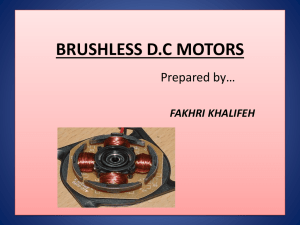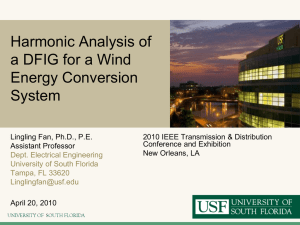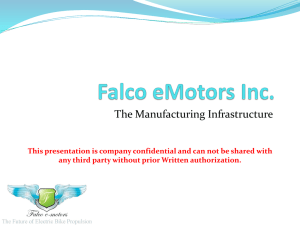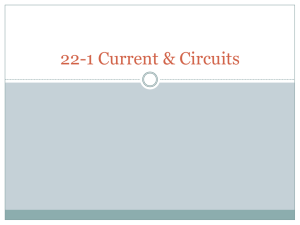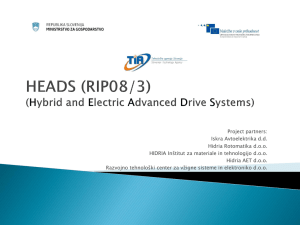EEEB283 Electrical Machines & Drives
advertisement
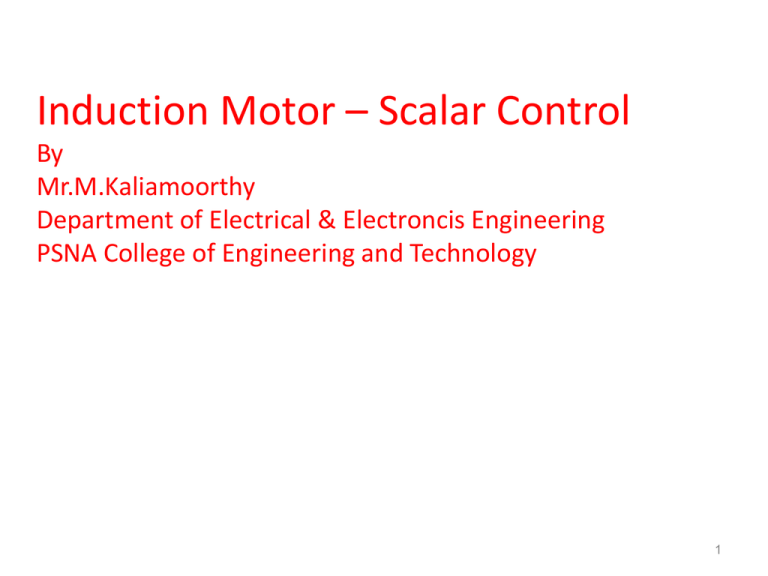
Induction Motor – Scalar Control By Mr.M.Kaliamoorthy Department of Electrical & Electroncis Engineering PSNA College of Engineering and Technology 1 Outline Introduction Speed Control of Induction Motors Pole Changing Variable-Voltage, Constant Frequency Variable Frequency Constant Volts/Hz (V/f) Control Open-loop Implementation Closed-loop Implementation Constant Airgap Flux Control References 2 INDUCTION MOTOR DRIVES Three-phase induction motor are commonly used in adjustable-speed drives (ASD). Basic part of three-phase induction motor : Three-phase windings Rotor windings • Stator Threephase supply • Rotor • Air gap Stator Air gap s Rotor m T Three-phase windings Rotor windings Threephase supply Stator Air gap s Rotor m T The stator winding are supplied with balanced three-phase AC voltage, which produce induced voltage in the rotor windings. It is possible to arrange the distribution of stator winding so that there is an effect of multiple poles, producing several cycle of magnetomotive force (mmf) or field around the air gap. The speed of rotation of field is called the synchronous speed s , which is defined by : ωs is syncronous speed [rad/sec] 2 Ns is syncronous speed [rpm] s or p is numbers of poles p ω is the supply frequency [rad/sec] f is the supply frequency [Hz] 120 f Ns Nm is motor speed p The motor speed m s (1 S ) The rotor speed or motor speed is : Where S is slip, as defined as : Three-phase windings m S S S Rotor windings Threephase supply Stator Air gap s Rotor m T Or S NS Nm NS The motor speed m s (1 S ) The rotor speed or motor speed is : Where S is slip, as defined as : Three-phase windings m S S S Rotor windings Threephase supply Stator Air gap s Rotor m T Or S NS Nm NS Equivalent Circuit Of Induction Motor Three-phase windings Where : Rotor windings Rs is resistance per-phase of stator winding Threephase supply Rr is resistance per-phase of rotor winding Air gap Stator Rotor m s Is Xs Xs is leakage reactance per-phase of the winding stator Xs is leakage reactance per-phase of the winding rotor T Xr’ Rs Im Xm is magnetizing reactance Ir’ Rr’/s Vs Xm Stator Rm Air gap motor Rm is Core losses as a reactance Performance Characteristic of Induction Motor Is Xs Xr’ Rs Im Ir’ Rr’/s Vs Xm Stator Rm Air gap motor Stator copper loss : Ps cu 3 I s Rs Rotor copper loss : Pr cu 3 ( I r ) 2 Rr 2 ' 2 Core losses : 2 V V Pc 3 m 3 s Rm Rm ' Performance Characteristic of Induction Motor - Power developed on air gap (Power fropm stator to ' rotor through air gap) : ' 2 Rr Pg 3 ( I r ) S ' 2 - Power developed by motor : Pd Pg Pr cu 3 ( I r ) ' Pd Pg (1 S ) or - Torque of motor : or Td Pd m Pd 60 Td 2 N m or Pg (1 S ) S (1 S ) Pg s Rr (1 S ) S Performance Characteristic of Induction Motor Input power of motor : Pi 3Vs I s cosm Pc Ps cu Pg Output power of motor : Po Pd Pno load Pd Pno load Po Efficiency : Pi Pc Ps cu Pg Performance Characteristic of Induction Motor If Pg (Pc Ps cu ) and Pd Pno load so, the efficiency can calculated as : Pd Pg (1 S ) 1 S Pg Pg Performance Characteristic of Induction Motor Generally, value of reactance magnetization Xm >> value Rm (core losses) and also X m 2 ( Rs 2 X s 2 ) So, the magnetizing voltage same with the input voltage : Vm Vs Therefore, the equivalent circuit is ; Is Xs Ii Im Xm Xr’ Rs Rr’/s Xm Vs Rm Po Pi Stator Air gap motor Is=Ir’ Ir’ Im Ir’ Rr’/s Vs Xs Xr’ Rs Stator Air gap rotor Performance Characteristic of Induction Motor Ii Xs Xr’ Rs Is=Ir’ Ir’ Im Rr’/s Vs Ir Po Pi Stator Air gap Vs ' Rr' Rs S ' j X s X r rotor Xm Ir Vs ' The rotor current is : Rr' ' Rs X s X r S 2 2 1 2 Ii Xs Xr’ Rs Is=Ir’ Ir’ Im Td Rr’/s Vs Po Pi Stator Air gap 3 Rr' Vs2 Rr' S s Rs S 2 X s X r' rotor Tmax Td Tst TL Tm=TL Operating point S=1 Nm =0 Torque – speed Characteristic Smax S=Sm S=0 m s Nm Ns 2 Introduction Te Pull out Torque (Tmax) Intersection point (Te=TL) determines the steady –state speed Te TL Trated What if the load must be operated here? s 1 sm rated rotors rotor’ 0 r Requires speed control of motor 15 Speed Control of IM • Given a load T– characteristic, the steady-state speed can be changed by altering the T– curve of the motor ' r 2 2 3R Vs Te ' 2 ss Rr 2 Rs X ls X lr s 3 2 4 s f P P 1 Varying voltage (amplitude) Varying line frequency Pole Changing 16 Speed Control of IM Variable-Voltage (amplitude), Constant Frequency Controlled using: Transformer (rarely used) Thyristor voltage controller thyristors connected in anti-parallel motor can be star or delta connected voltage control by firing angle control (gating signals are synchronized to phase voltages and are spaced at 60 intervals) Only for operations in Quadrant 1 and Quadrant 3 (requires reversal of phase sequence) also used for soft start of motors 17 Speed Control of IM Variable-Voltage (amplitude), Constant Frequency Voltage can only be reduced from rated Vs (i.e. 0 < Vs ≤ Vs,rated) From torque equation, Te Vs2 When Vs , Te and speed reduces. If terminal voltage is reduced to bVs, (i.e. Vs = bVs,rated) : ' r 3R Te ss Rr' Rs s bV 2 s 2 X ls X lr 2 Note: b 1 18 Speed Control of IM Variable-Voltage (amplitude), Constant Frequency Suitable for applications where torque demand reduces with speed (eg: fan and pump drives where TL m2) Suitable for NEMA Class D (high-slip, high Rr’) type motors High rotor copper loss, low efficiency motors get appreciable speed range Practical speed range 19 Speed Control of IM Variable Voltage (amplitude), Constant Frequency Disadvantages: limited speed range when applied to Class B (low-slip) motors Excessive stator currents at low speeds high copper losses Distorted phase current in machine and line (harmonics introduced by thyristor switching) Poor line power factor (power factor proportional to firing angle) Hence, only used on low-power, appliance-type motors where efficiency is not important e.g. small fan or pumps drives 20 Speed Control of IM Variable Frequency Speed control above rated (base) speed Requires the use of PWM inverters to control frequency of motor Frequency increased (i.e. s increased) Stator voltage held constant at rated value Airgap flux and rotor current decreases Developed torque decreases Te (1/s) For control below base speed – use Constant Volts/Hz method 21 Constant Volts/Hz (V/f) Control Airgap flux in the motor is related to the induced stator voltage E1 : E1 Vs ag f f Assuming small voltage drop across Rs and Lls For below base speed operation: Frequency reduced at rated Vs - airgap flux saturates (f ,ag and enters saturation region oh B-H curve): - excessive stator currents flow - distortion of flux wave - increase in core losses and stator copper loss Hence, keep ag = rated flux stator voltage Vs must be reduced proportional to reduction in f (i.e. maintaining Vs / f ratio) 22 Constant Volts/Hz (V/f) Control Max. torque remains almost constant For low speed operation: can’t ignore voltage drop across Rs and Lls (i.e. E1 Vs) poor torque capability (i.e. torque decreased at low speeds shown by dotted lines) stator voltage must be boosted – to compensate for voltage drop at Rs and Lls and maintain constant ag E1 Vs ag f f Tmax Vs 2 s For above base speed operation (f > frated): stator voltage maintained at rated value Same as Variable Frequency control (refer to slide 13) 23 Constant Volts/Hz (V/f) Control Vs Vs vs. f relation in Constant Volts/Hz drives Boost - to compensate for voltage drop at Rs and Lls Vrated Linear offset curve – • for high-starting torque loads • employed for most applications Linear offset Boost Non-linear offset curve – • for low-starting torque loads Non-linear offset – varies with Is frated f 24 Constant Volts/Hz (V/f) Control • For operation at frequency K times rated frequency: – fs = Kfs,rated s = Ks,rated (1) (Note: in (1) , speed is given as mechanical speed) KVs ,rated , when f s f s ,rated – Stator voltage:Vs (2) Vs ,rated , when f s f s ,rated –Voltage-to-frequency ratio = d = constant: d Vs,rated s,rated (3) 25 Constant Volts/Hz (V/f) Control For operation at frequency K times rated frequency: Hence, the torque produced by the motor: Te ' r 3R ss Rr' Rs s Vs 2 2 2 K X ls X lr 2 (4) where s and Vs are calculated from (1) and (2) respectively. 26 Constant Volts/Hz (V/f) Control For operation at frequency K times rated frequency: The slip for maximum torque is: smax Rr' (5) Rs K 2 X ls X lr 2 2 The maximum torque is then given by: Tmax Vs 3 2 2 s R R K 2 X X s ls lr s 2 2 (6) where s and Vs are calculated from (1) and (2) respectively. 27 Constant Volts/Hz (V/f) Control Rated (Base) frequency Constant Torque Area (below base speed) Field Weakening Mode (f > frated) • Reduced flux (since Vs is constant) • Torque reduces Constant Power Area (above base speed) Note: Operation restricted between synchronous speed and Tmax for motoring and braking regions, i.e. in the linear region of the torque-speed curve. 28 Constant Volts/Hz (V/f) Control Constant Torque Area Constant Power Area 29 Example A 4-pole, 3 phase, 400 V, 50 Hz, 1470 rpm induction motor has a rated torque of 30 Nm. The motor is used to drive a linear load with characteristic given by TL = K, such that the speed equals rated value at rated torque. If a constant Volts/Hz control method is employed, calculate: The constant K in the TL - characteristic of the load. Synchronous and motor speeds at 0.6 rated torque. If a starting torque of 1.2 times rated torque is required, what should be the voltage and frequency applied at start-up? State any assumptions made for this calculation. Answers: K = 0.195, synchronous speed = 899.47 rpm & motor speed = 881.47 rpm, At start up: frequency = 1.2 Hz, Voltage = 9.6 V 30 Constant Volts/Hz (V/f) Control – Open-loop Implementation PWM Voltage-Source Inverter (VSI) Note: e= s = synchronous speed 31 Constant Volts/Hz (V/f) Control – Open-loop Implementation • Most popular speed control method because it is easy to implement • Used in low-performance applications – where precise speed control unnecessary • Speed command s* - primary control variable • Phase voltage command Vs* generated from V/f relation (shown as the ‘G’ in slide 23) – Boost voltage Vo is added at low speeds – Constant voltage applied above base speed • Sinusoidal phase voltages (vabc*) is then generated from Vs* & s* where s* is obtained from the integral of s* • vabc* employed in PWM inverter connected to motor 32 Constant Volts/Hz (V/f) Control – Open-loop Implementation Problems in open-loop drive operation: Motor speed not controlled precisely P m 2 P s sl 2 r primary control variable is synchronous speed s actual motor speed r is less than s due to sl sl depends on load connected to motor sl cannot be maintained since r not measured can lead to operation in unstable region of T- characteristic stator currents can exceed rated value – endangering inverterconverter combination Problems (to an extent) can be overcome by: Open-loop Constant Volts/Hz Drive with Slip Compensation Closed-loop implementation - having outer speed loop with slip regulation 33 Constant Volts/Hz (V/f) Control – Open-loop Implementation Open-loop Constant Volts/Hz Drive with Slip Compensation - Slip speed is estimated and added to the reference speed r* Vdc = Vd Idc Slip Compensator sl r* Note: e= s = synchronous speed 34 Constant Volts/Hz (V/f) Control – Open-loop Implementation Open-loop Constant Volts/Hz Drive with Slip Compensation • How is sl estimated in the Slip Compensator? • Using T- curve, sl Te • sl can be estimated by estimating torque where: Te Pag s Pin PSCL inverterlosses s Pin Vdc I dc Te sl Te ,rated (8) sl ,rated (7) Note: In the figure, slip= sl = slip speed syn= s = synchronous speed (9) 35 Constant Volts/Hz (V/f) Control – Closed-loop Implementation Open-loop system (as in slide 23) Slip Controller Note: e= s = synchronous speed 36 Constant Volts/Hz (V/f) Control – Closed-loop Implementation Reference motor speed r* is compared to the actual speed r to obtain the speed loop error Speed loop error generates slip command sl* from PI controller and limiter Limiter ensures that the sl* is kept within the allowable slip speed of the motor (i.e. sl* slip speed for maximum torque) sl* is then added to the actual motor speed r to generate synchronous speed command s* (or frequency command) s* generates voltage command Vs* from V/f relation Boost voltage is added at low speeds Constant voltage applied above base speed Scheme can be considered open loop torque control (since T s) within speed control loop 37 Constant Airgap Flux Control Constant V/f control employs the use of variable frequency voltage source inverters (VSI) Constant Airgap Flux control employs variable frequency current source inverters or current-controlled VSI Provides better performance compared to Constant V/f control with Slip Compensation airgap flux is maintained at rated value through stator current control Speed response similar to equivalent separately-excited dc motor drive but torque and flux channels still coupled Fast torque response means: High-performance drive obtained Suitable for demanding applications Able to replace separately-excited dc motor drives Above only true is airgap flux remains constant at rated value 38 Constant Airgap Flux Control • Constant airgap flux in the motor means: E1 ag Lm I m constant 2f Assuming small voltage drop across Rs and Lls • For ag to be kept constant at rated value, the magnetising current Im must remain constant at rated value • Hence, in this control scheme stator current Is is controlled to maintain Im at rated value Controlled to maintain Im at rated Rs Lls Is Llr’ + + Vs – Ir ’ Lm maintain at rated E1 Vs Rr’/s Im – 39 Constant Airgap Flux Control • From torque equation (with ag kept constant at rated value), since ss = sl and ignoring Rs and Lls, 2 P Vs Te 3 2 ss Rr' Rs s 2 Rr P E1 3 2 2 ' 2 sl R 2 2 r X ls X lr s s Llr sl ' r R ' • By rearranging the equation: 2 P E Te 3 12 2 s R ' r sl Rr' sl P 2 T 3 ag e 2 2 2 Llr Rr' sl R ' r sl 2 Llr 2 Te sl sl can be varied instantly instantaneous (fast) 40 Te response Constant Airgap Flux Control Constant airgap flux requires control of magnetising current Im which is not accessible From equivalent circuit' (on slide 31): R jsl Tr 1 js L'lr r Is Im , s r Im Is (10) ' Tr 1 j sl R js ( L'lr Lm ) r 1 r s From equation (10), plot Is against sl when Im is kept at rated value. Drive is operated to maintain Is against sl relationship when frequency is changed to control speed. Hence, control is achieved by controlling stator current Is and stator frequency: Is controlled using current-controlled VSI Control scheme sensitive to parameter variation (due to Tr and r) L'lr elec Lr Note: Tr ' , r , sl selec 41 r Rr Lm Constant Airgap Flux Control Implementation Current Controlled VSI 3-phase supply Rectifier C Current controller options: • Hysteresis Controller • PI controller + PWM r* + PI - Voltage Source Inverter (VSI) IM Current controller slip |Is| i*a i*b + s r + r i*c Equation (10) (from slide 33) 42 Current-Controlled VSI Implementation • Hysteresis Controller i*a i*b i*c + Voltage Source Inverter (VSI) + + Motor 43 Current-Controlled VSI Implementation • PI Controller + Sinusoidal PWM i*a i*b i*c + PI + PWM PI + •Due to interactions between phases (assuming balanced conditions) actually only require 2 controllers Voltage Source Inverter (VSI) PWM PI PWM Motor 44 Current-Controlled VSI Implementation • PI Controller + Sinusoidal PWM (2 phase) i*a i d* i*b abcdq PI dq abc i q* PI PWM Voltage Source Inverter (VSI) i*c iq id abcdq Motor 45 References Krishnan, R., Electric Motor Drives: Modeling, Analysis and Control, Prentice-Hall, New Jersey, 2001. Bose, B. K., Modern Power Electronics and AC drives, PrenticeHall, New Jersey, 2002. Trzynadlowski, A. M., Control of Induction Motors, Academic Press, San Diego, 2001. Rashid, M.H, Power Electronics: Circuit, Devices and Applictions, 3rd ed., Pearson, New-Jersey, 2004. Nik Idris, N. R., Short Course Notes on Electrical Drives, UNITEN/UTM, 2008. Ahmad Azli, N., Short Course Notes on Electrical Drives, UNITEN/UTM, 2008. 46

